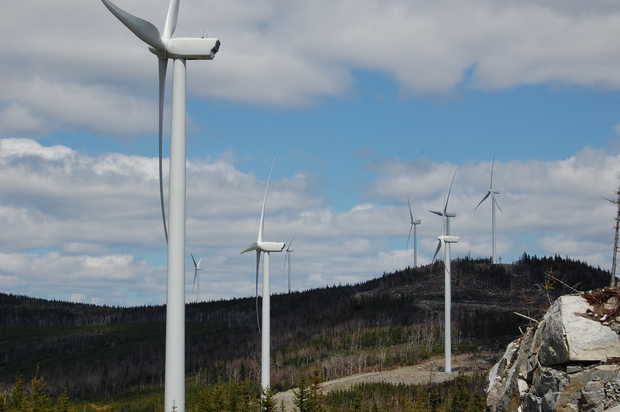Maine will not be able to accomplish the state-mandated goals of building 2,000 megawatts of wind power on land by 2015.
That’s one conclusion of two studies issued this week by the governor’s energy office and an independent group of researchers.
The studies also urged reconsideration of the landmark 2008 law that allowed wind turbines to be built in ecologically and scenically important areas of the state.
“No one imagines that we’ll be meeting the goal at 2015,” said Stephen Ward, co-author of “Maine Wind Assessment 2012.”
“In order to meet the 2015 goal, at least 552 new turbines will have to be permitted and become operational by 2012, and – depending on the size of the turbines – potentially as many as 1,103 turbines will be needed,” Ward’s report states.
The state is “making progress, though, in meeting the off-shore wind goals for 2020 and 2030,” says Ward’s report, although none are currently constructed.
Maine currently has eight large-scale, land-based wind projects operating that total 345.5 megawatts and five more projects in the pipeline that will provide a total of 300.8 MW.
Ward’s report was produced by Coastal Enterprises, Inc. (CEI) for the governor’s Office of Energy Independence and Security.
CEI’s report, in turn, formed the basis of a report given Wednesday to a legislative committee by Ken Fletcher, head of the governor’s energy office.
That report, “Maine Wind Energy Development Assessment,” includes the same conclusion about Maine’s inability to meet its legally-mandated goals.
“We’re not saying anybody has failed,” Fletcher said. “It’s just that the economic realities of the economy and the cost structure of wind seems to make it more of a challenge to get to the installed capacity.”
Both reports recommend changing state law to reflect more modest goals for 2015.
That had Jeremy Payne worried. Payne’s the head of the Maine Renewable Energy Association, which represents the state’s wind developers.
“I don’t understand the purpose of stepping back from the goal,” said Payne. “Why would we want to do that and send a bad signal to the investors – it’s a confusing signal to send to them at the wrong time.”
Payne said opponents to wind projects who mount legal appeals were to blame for slow progress towards Maine’s wind development goals.
“You’re talking years up on years to get a decision,” said Payne.
The reports were done at the behest of legislators on the Utilities and Energy Committee who wanted a review of the Wind Energy Act.
The act was the product of a task force of wind energy supporters empaneled by then-Gov. John Baldacci, a strong booster of wind power. It gave developers a fast track to putting up wind turbines in some of the state’s treasured landscapes, including sensitive ecological areas above 2700 feet, and established aggressive goals that would have placed up to 2000 turbines on Maine’s landscape by 2030.
The map of that “Expedited Wind Zone,” was put together by the task force in closed-door meetings for which no written records were kept. The CEI report said that redoing the map with a more diverse group would be a good idea.
“The Governor, the Legislature or DEP could convene a panel of disinterested parties to identify where in Maine expedited permitting could go forward in a way that causes no harm to local residents or environments,” wrote the authors. “This would amount to re-doing the work of the 2007 Wind Energy Task Force that, largely behind closed doors, assembled the original criteria for expedited permitting and its listing of scenic features.”
The report also says that the conflict that’s arisen in recent years over siting of wind tower projects might be addressed by a different – more public — process.
“It may also be desirable to convene a group that is not composed entirely of interested stakeholders as also was the case in 2007,” the report states.
Dylan Voorhees, a Natural Resources Council of Maine energy expert who participated in the task force meetings, said he’s open to redoing the map.
“Reconvening some kind of a task force or study group to look at the expedited area could be considered, but it would be a major and complicated undertaking,” said Voorhees.
One wind energy opponent said he was gratified by the two studies.
“I’m glad to see that the problems that have cropped up with expedited permitting have started to at least be addressed,” said Alan Michka of Lexington Township, chairman of Friends of the Highland Mountains. “Time will tell if they’re going to really be addressed or this is just lip service.”
Fletcher’s report recommended lawmakers find better way to evaluate the visual impacts of wind towers.. and adopt policies requiring consideration of the cumulative impacts of multiple wind developments.
And the CEI report notes that while two state agencies – the Land Use Regulation Commission and the Maine Historic Preservation Commission — recognize sporting camps as “an iconic and historic cultural resource” worthy of protection from development, the state’s wind power laws do not, and perhaps should.
“We need to find an appropriate balance and process, not that we don’t want to do projects,” Fletcher said.
For example, Fletcher said that a proposed cluster of turbines in the expedited zone around the Down East lakes region – home to historic sporting camps — should be carefully scrutinized.
“Maybe that is such a unique and special area we should be considering that being removed from the expedited zone because of the uniqueness of it,” he said.
Both reports addressed another significant conflict between wind proponents and opponents – whether wind energy reduces greenhouse gases.
“The more wind runs, the less natural gas gets burned to generate electricity,” said Ward, an energy expert who represented the state’s utility consumers as the state’s Public Advocate for 20 years. “We really have no doubt that there is a beneficial effect of wind development in terms of greenhouse gases.”








